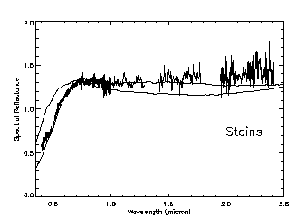The European Space Agency has launched successfully on 2 March 2004 the Rosetta mission whose scientific objectives are the study of the primitive materials of the solar system, in order to answer the key questions of its formation. The mission involves passing by two asteroids and the landing on Churyumov- Gerasimenko comet. Thanks to the large precision of the launching in the interplanetary orbit of the Rosetta probe, ESA has announced the availability of more than 120 m/s of D v to choose between several possibilities the asteroid targets to meet (Barucci et al., 2004a). All candidates were observed during several observing campaigns carried out by the researchers of Paris Observatory with ESO-NTT, the Canaries-Galileo telescope and IRTF at Mauna Kea, Hawaii. The observations with IRTF (Birlan et al, 2004) were carried out in remote control from Meudon, with the system. During the Scientific Committee of the Rosetta mission on 11 March 2004, M. Fulchignoni from LESIA, as Interdisciplinary Scientist (IDS) for asteroid science proposed to include in the basic program of the mission the overflight of the asteroids 21 Lutetia and 2867 Steins. This proposal was based on the scientific interest of these objects : both have a particular spectrum which seems characteristic of the most primitive asteroids. Moreover, Lutetia has a size which will allow to determine its mass and to deduce its density. The Scientific Committee of the mission accepted this proposal and thus 21 Lutetia and 2867 Steins are the target asteroids of the Rosetta mission.


Barucci et al., 2004b, 21 Lutetia and 2867 Steins : the Rosetta Asteroid Targets. A&A, in preparation Birlan et al., Near-Ir Spectroscopy of asteroids21 Lutetia, 89 Julia, 140 Siwa, 2181 Fogelin, and 5480 (1989YK8), potential targets of the Rosetta mission ; remote observations campaign on IRTF , New Astronomy, Vol. 9 (5), 343-351, 2004.
